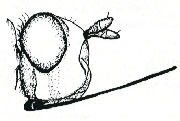
Introduction
Zodion are small greyish Conopids, with single bent in their long snout. They inhabit dry grassland habitats. Most often, they are found visiting flowers. Sweeping low grass vegetation with a net may also render Zodion. Their larvae are endoparasites of Halictus-bees.
Mei M. and Stuke J.-H. 2008. Remarks on Zodion nigritarsis (Strobl, 1902) and other European species of Zodion Latreille, 1796, with a revised key (Diptera, Conopidae). Tijdschrift voor Entomologie 151: 3–10.
Van Veen M. 1984. De Blaaskopvliegen en roofvliegen van Nederland en België. Jeugdbondsuitgeverij, Utrecht.